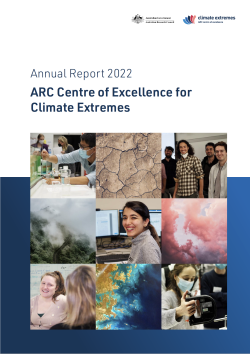Climate models are the main tools available to climate scientists worldwide to predict future changes in the ocean-atmosphere-land system, and these are widely used to study climate processes. Climate modelling also underpins much of the research performed throughout the ARC Centre of Excellence for Climate Extremes. The Modelling research program improves Australia’s climate model, the Australian Community Climate and Earth System Simulator (ACCESS), to benefit the research and prediction across our Centre and the nation.
The Modelling program works closely with the newly established Australian Earth System Simulator (AESS) to achieve its goals. The AESS established a new Earth System Modelling Community Working Group, co-led by Centre researcher Associate Professor Shayne McGregor, which meets fortnightly. The group brings together Australian scientists interested in climate modelling and provides a platform for exchange, networking, and teamwork to advance Australia’s modelling capability.
The Modelling program has put together an overview of climate modelling, which is now available on the Centre’s website for anyone interested. The overview is a great resource for the non-research audience to learn about climate models and their different types and the role of the Coupled Model Intercomparison Project for the Intergovernmental Panel on Climate Change reports.
Additionally, a set of Briefing notes has been published that highlight research performed using particular model configurations. These Briefing notes highlight the work by postdoctoral researchers from the Centre and cover the land (Dr Mengyuan Mu), atmosphere (Dr Hooman Ayat) and ocean (Dr Wilma Huneke).

PROJECT 1
High-resolution regional atmospheric modelling
AUS2200 is a community-based project that aims
to develop high-resolution regional modelling capacity at 2.2km grid spacing across Australia
and surrounding ocean using ACCESS. The project provides a common platform that facilitates research and model-development activities that advance scientific understanding of important atmospheric processes across a wide range of scales, from continent-wide to kilometre. The project monthly meetings, led by Centre Chief Investigator Dr Yi Huang, are regularly attended by Centre researchers and colleagues from the Bureau of Meteorology, National Computational Infrastructure and the AESS.
Over the past year, major optimisation efforts led by the Computational Modelling Support team have led to significant improvements in the model’s computational performance and efficiency, with the speed of the modelling workflow being improved by a factor of 10, from three model days per day to over 30. A number of community-driven pilot projects have been conducted during 2022 to 2023, wherein AUS2200 simulations are used to investigate a range of high-impact extreme weather events across Australia.
Important highlights include a research project led by Dr Hooman Ayat, with AUS2200 simulations used to investigate the role of frontal dynamics in the 2019/2020 Black Summer megafire event
in south-east Australia. Moreover, AUS2200 simulations of the 2022 NSW/QLD extreme rainfall event were examined in two hackathons organised by the Weather and Climate Interactions research program during February and March 2023. With a focus on initial evaluation of the simulations, the hackathons were attended by over 20 early career researchers across several universities, plus members of the Computational Modelling Support team and colleagues from the Bureau of Meteorology.
PROJECT 2
Developing Australia’s coupled modelling capacity
The recent focus of Australia’s coupled model development is to increase model grid resolution. The coupled model combines an ocean, sea ice, atmosphere and land component. The current generation of the coupled model has a 1° resolution, which equates to approximately 100 kilometres distance between neighbouring grid points.
Many processes occurring in the climate system are not captured with such a model grid. A new, developed- model configuration has an increased grid resolution for the ocean component (0.25°). Current work evaluates the model performance compared to observations, as well as the previous and coarser model, and uses the information to improve various details in the configuration.

RESEARCH SNAPSHOT

Centre researcher Dr Luwei Yang led a study on the role of ocean waves in the response of the Southern Ocean to changes in westerly winds. The westerly winds over the Southern Ocean have been increasing over the last few decades and it is important to understand how this increase in the winds affects the global ocean circulation. The largest current on Earth, the Antarctic Circumpolar Current, is situated in the Southern Ocean, and observations as well as modelling work have indicated that the current strength is insensitive to the increased winds.
The study by Yang et al., however, points out that the previous work has not included a certain type of oceanic waves, lee waves, and that these have the ability to change the current’s response to winds. The findings of the study suggests that future modelling work should take the effect of lee waves into account in order to achieve a more accurate understanding of how the global ocean circulation responds to climate change.
Yang, L., Nikurashin, M., Hogg, A. M., & Sloyan, B. M. (2023). Lee waves break eddy saturation of the Antarctic Circumpolar Current. Geophysical Research Letters, 50, e2023GL103866. https://doi.org/10.1029/2023GL103866.

ARC Centre of Excellence for Climate Extremes – Annual Report 2023
From the Chair of the Advisory Board
Climate Science Leaders of the Future
Weather and Climate Interactions Research Program
Attribution and Risk Research Program
Ocean Extremes Research Program
Computational Modelling Systems
Governance, Management and our Commitment to Equity, Diversity and Inclusion

